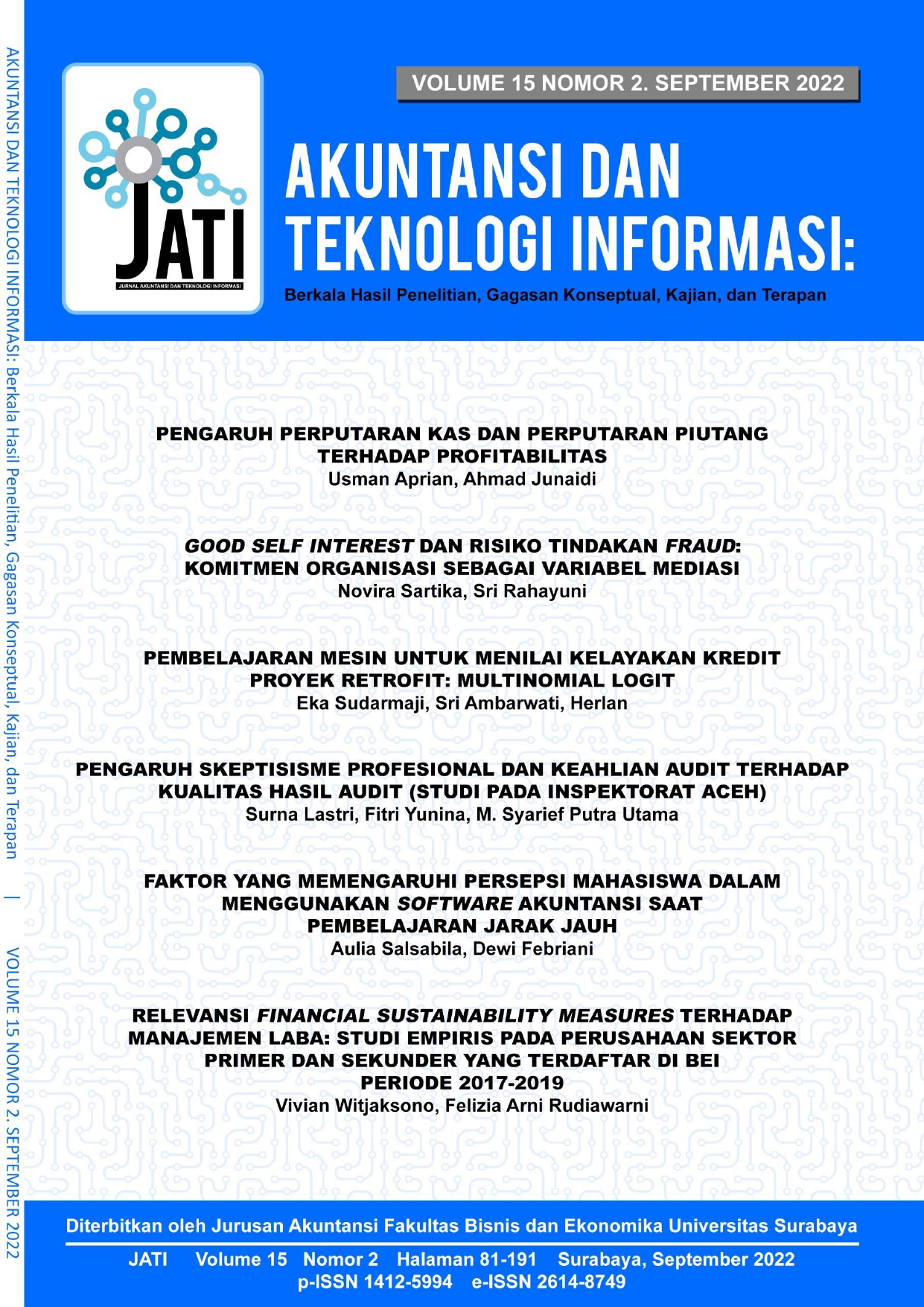FAKTOR YANG MEMENGARUHI PERSEPSI MAHASISWA DALAM MENGGUNAKAN SOFTWARE AKUNTANSI SAAT PEMBELAJARAN JARAK JAUH
 Abstract Views:
685 times
Abstract Views:
685 times
 PDF Downloads:
607 times
PDF Downloads:
607 times
Abstract
This study discusses the factors influencing students’ perceptions of using accounting software during distance learning. This study uses a descriptive quantitative approach. The data were obtained from questionnaires distributed to 134 students. SEM-PLS method with smartPLS was employed in this study. The result of this study states that distance learning has a negative effect on computer anxiety and computer anxiety itself negatively affects computer self-efficacy, perceived ease of use, and perceived usefulness. Computer self-efficacy has a positive effect on perceived ease of use. Perceived ease of use has a positive effect on perceived usefulness. This study examines only the factors influencing student perception and intention to use accounting software. This study provides empirical evidence on the effect of transactional distance and other factors such as computer anxiety and computer self-efficacy on perceptions of using accounting software. In addition, this research can enrich study materials or references for the future research.
Downloads
References
Abdullah, F., Ward, R., & Ahmed, E. (2016). Investigating the influence of the most commonly used external variables of TAM on students’ Perceived Ease of Use (PEOU) and Perceived Usefulness (PU) of e-portfolios. Computers in Human Behavior, 63, 75–90. https://doi.org/10.1016/j.chb.2016.05.014
Achim, N., & Kassim, A. Al. (2015). Computer Usage: The Impact of Computer Anxiety and Computer Self efficacy. Procedia - Social and Behavioral Sciences, 172, 701–708. https://doi.org/10.1016/j.sbspro.2015.01.422
Adi, I. N. R., & Yanti, P. E. P. (2018). Pengaruh Computer Attitude, Computer Self Efficiacy, dan Trust Terhadap Minat Menggunakan Software Akuntansi Pada Karyawan LPD Se-Kota Denpasar. Jurnal Ilmiah Akuntansi & Bisnis, 3(1), 58–70.
Afrillyanie, M. (2007). Pengaruh Computer Anxiety Terhadap Computer Self-efficacy Dimoderasi Oleh Locus of Control Dilihat Dari Karakteristik Individu. 1–19.
Al-Gahtani, S. S. (2016). Empirical investigation of e-learning acceptance and assimilation: A structural equation model. Applied Computing and Informatics, 12(1), 27–50. https://doi.org/10.1016/j.aci.2014.09.001
Davis, F. D. (1989). Perceived usefulness, perceived ease of use, and user acceptance of information technology. MIS Quarterly: Management Information Systems, 13(3), 319–339. https://doi.org/10.2307/249008
Davis, F. D., Bagozzi, R. P., & Warshaw, P. R. (1989). User Acceptance of Computer Technology: A Comparison of Two Theoretical Models. Management Science, 35(8), 982–1003. https://doi.org/10.1287/mnsc.35.8.982
Davis, F. D., & Venkatesh, V. (1996). A critical assessment of potential measurement biases in the technology acceptance model: Three experiments. International Journal of Human Computer Studies, 45(1), 19–45. https://doi.org/10.1006/ijhc.1996.0040
Devi, N. L. N. S., & Suartana, I. W. (2014a). Analisis Technology Acceptance Model (Tam) Terhadap Penggunaan Sistem Informasi Di Nusa Dua Beach Hotel & Spa. E-Jurnal Akuntansi Universitas Udayana, 6(1), 167–184. http://ojs.unud.ac.id/index.php/Akuntansi/article/view/7797
Devi, N. L. N. S., & Suartana, I. W. (2014b). Analisis Technology Acceptance Model (Tam) Terhadap Penggunaan Sistem Informasi Di Nusa Dua Beach Hotel & Spa. E-Jurnal Akuntansi Universitas Udayana, 6(1), 167–184.
Fauziyyah, R., Awinda, R. C., & Besral, B. (2021). Dampak Pembelajaran Jarak Jauh terhadap Tingkat Stres dan Kecemasan Mahasiswa selama Pandemi COVID-19. Jurnal Biostatistik, Kependudukan, dan Informatika Kesehatan,1(2),113. https://doi.org/10.51181/bikfokes.v1i2.4656
Hambali, F., Akhirson, A., & Wijayanti., R. (2011). Analisis Technology Acceptance Model (TAM) Terhadap Faktor-Faktor Yang Memengaruhi Penerimaan Nasabah terhadap Layanan Internet Banking (Studi Empiris terhadap Nasabah Bank di Depok). In Proceeding PESAT (Psikologi, Ekonomi, Sastra, Arsitektur, dan Sipil (Vol. 4, pp. 121–127).
Hambali, Fitriasyah. (2009). Analisis Technology Acceptance Model ( Tam ) Terhadap Faktor - Faktor Yang Memengaruhi Penerimaan Nasabah Terhadap Layanan Internet Banking. In Nasabah, Penerimaan Layanan, Terhadap Empiris, Studi Nasabah, Terhadap Di, Bank.
Handayani, R. (2010). Analisis pengaruh computer anxiety dan self-efficacy terhadap keahlian penggunaan internet pada mahasiswa. Riset Manajemen Dan Akuntansi Volume, 1(2), 64–77.
Harahap, A. C. P., Permatasari, D., & Rivai, S. (2020). Analisis Tingkat Stres Akademik Pada Mahasiswa Selama Pembelajaran Jarak Jauh Dimasa Covid-19. Biblio Couns : Jurnal Kajian Konseling Dan Pendidikan, 3(1), 10–14. https://doi.org/10.30596/bibliocouns.v3i1.4804
Hatta, M., & Marietza, F. (2013a). Kecemasan dalam Penggunaan Software Akuntansi dari Perspektif Gender dan Pengaruhnya terhadap Keahlian Pemakai dengan Locus Of Control sebagai Variabel Moderasi. Simposium Nasional Akuntansi Xvi, September 2013, 4067–4565.
Hatta, M., & Marietza, F. (2013b). Kecemasan dalam Penggunaan Software Akuntansi dari Perspektif Gender dan Pengaruhnya terhadap Keahlian Pemakai dengan Locus Of Control sebagai Variabel Moderasi. Simposium Nasional Akuntansi Xvi, September 2013, 4067–4565. http://repository.unib.ac.id/id/eprint/6414
Hauser, R., Paul, R., & Bradley, J. (2012). Computer self-efficacy, anxiety, and learning in online versus face to face medium. Journal of Information Technology Education:Research, 11(1), 141–154. https://doi.org/10.28945/1633
Hermanto, S. B., & Patmawati, P. (2017). Determinan Penggunaan Aktual Perangkat Lunak Akuntansi Pendekatan Technology Acceptance Model. Jurnal Akuntansi Dan Keuangan, 19(2), 67–81. https://doi.org/10.9744/jak.19.2.67-81
Hong, W., Thong, J. Y. ., Wong, W., & Tam, K. (2001a). Determinants of User Acceptance of Digital Libraries: An Empirical Examination of Individual Differences and System Characteristics. Journal of Organizational Computing and Electronic Commerce, and Omega, 18(3), 97–124.
Hu, P. J., Chau, P. Y. K., Sheng, O. R. L., & Tam, K. Y. (2012). Examining Acceptance Model Using Physician of Acceptance Telemedicine Technology. Journal of Management Information Systems, 16(2), 91–112.
Husky, M. M., Kovess-Masfety, V., & Swendsen, J. D. (2020). Stress and anxiety among university students in France during Covid-19 mandatory confinement. Comprehensive Psychiatry, 102, 152191. https://doi.org/10.1016/j.comppsych.2020.152191
Igbaria, M., & Iivari, J. (1995). The effects of self-efficacy on computer usage. Omega, 23(6), 587– 605. https://doi.org/10.1016/0305-0483(95)00035-6
Indriantoro, N. (2000). Pengaruh Computer Anxiety Terhadap Keahlian Dosen Dalam Penggunaan Komputer. Jurnal Akuntansi Dan Auditing, 4(2), 191–210.
Irmadhani, & Adhi, N. M. (2012). Pengaruh persepsi kebermanfaatan, persepsi kemudahan penggunaan terhadap Penggunaan Online Banking Pada Mahasiswa S1 Fakultas Ekonomi Universitas Negeri Yogyakarta, 1–20.
Kamel, S., & Hassan, A. (2011a). Assessing the Introduction of Electronic Banking in Egypt Using the Technology Acceptance Model. July 2014, 1–25. https://doi.org/10.4018/978-1-59140-061- 5.ch001
Kamel, S., & Hassan, A. (2011b). Assessing the Introduction of Electronic Banking in Egypt Using the Technology Acceptance Model. January 2003, 1–25. https://doi.org/10.4018/978-1-59140-061- 5.ch001
Kučírková, L., Kučera, P., & Vydrová, H. V. (2012). Study results and questionnaire survey of students in the lessons of business english E-learning course in comparison with face-to-face teaching. Journal on Efficiency and Responsibility in Education and Science, 5(3), 173–184. https://doi.org/10.7160/eriesj.2012.050306
Kumara, I. K. A., Adiputra, I. M. P., & Ni Luh Gede Erni Sulindawati. (2014a). Pengaruh computer anxiety dan computer attitude terhadap keahlian karyawan bagian akuntansi yang menggunkan komputer. E-Journal S1 Ak Universitas Pendidikan Ganesha, 2(1).
Kumara, I. K. A., Adiputra, I. M. P., & Ni Luh Gede Erni Sulindawati. (2014b). Pengaruh Computer Anxiety dan Computer Attitude terhadap Keahlian Karyawan Bagian Akuntansi yang Menggunkan Komputer. E-Journal S1 Ak Universitas Pendidikan Ganesha, 2(1).
Maharani, P. N. (2019). Pengaruh Computer Anxiety Dan Computer Attitude Terhadap Keahlian Pemakaian Software Akuntansi Pada Mahasiswa Jurusan Akuntansi Di Universitas Mahasaraswati Denpasar Putu. Jurnal Sains Akuntansi Dan Manajemen, 1(2), 236–270.
Maharsi, S., & Mulyadi, Y. (2007). Faktor-Faktor Yang Memengaruhi Minat Nasabah Menggunakan Internet Banking dengan Menggunakan Kerangka Technology Acceptance Model (TAM). Jurnal Akuntansi Dan Keuangan, 9(1), 18–28. https://doi.org/10.9744/jak.9.1.pp.18-28
Moore, M. G. (1993). Theory of transactional distance. International Review of Research in Open and Distance Learning, 10(6), 21–50.
Muflichatus Salamiyah. (2019). ANALISIS FAKTOR-FAKTOR YANG MEMENGARUHI EFEKTIVITAS PENGGUNAAN SISTEM INFORMASI AKUNTANSI.
Nasution, S. L., Windari, F., Harahap, S. Z., & Elvina, E. (2021). Pengaruh Media Pembelajaran Online Dalam Pemahaman Dan Minat Belajar Mahasiswa Pada Bidang Studi Akutansi Di Feb Universitas Labuhanbatu. Ecobisma (Jurnal Ekonomi, Bisnis Dan Manajemen), 8(1), 67–75.
NurCita, B., & Susantiningsih, T. (2020). Dampak Pembelajaran Jarak Jauh Dan Physical Distancing Pada Tingkat Kecemasan Mahasiswa Fakultas Kedokteran Universitas Pembangunan Nasional “Veteran” Jakarta. Journal of Borneo Holistic Health, 3(1), 58–68.
Parasara, A. (2014). Pengaruh Computer Anxiety Pada Computer Self-efficacy. E-Jurnal Akuntansi, 7(2), 289–298.
Parasara, A. A. P. (2014). Pengaruh Computer Anxiety Pada Computer Self-efficacy. E-Jurnal Akuntansi, 7(2), 289–298.
Pranata, S., Purnamasari, D. L., & Handayani, M. (2020). Pengaruh Computer Anxiety, Computer Attitude, Dan Computer Self-efficacy Terhadap Minat Mahasiswa Komputerisasi Akuntansi Menggunakan Software Akuntansi. Jurnal EBI, 1(1), 54–63. https://doi.org/10.52061/ebi.v1i1.8
Putra, aprilian kusuma. (2016). Pengaruh Computer Anxiety, Computer Attitude dan Computer Self- efficacy Terhadap Minat Mahasiswa Akuntansi Menggunakan Software Akuntansi.
Rahmatika, U., & Fajar, M. A. (2019). Faktor - Faktor Yang Memengaruhi Minat Penggunaan Electronic Money: Integrasi Model Tam – Tpb Dengan Perceived Risk. Nominal: Barometer Riset Akuntansi Dan Manajemen, 8(2), 274–284. https://doi.org/10.21831/nominal.v8i2.26557
Saade, R., & Kira, D. (2006). The Emotional State of Technology Acceptance. Proceedings of the 2006 InSITE Conference, 3. https://doi.org/10.28945/2945
Saade, R., & Kira, D. (2009). Computer Anxiety in E-Learning: The Effect of Computer Self-Efficacy.
Proceedings of the 2009 InSITE Conference, 8. https://doi.org/10.28945/3386
Setiawan, H. (2012). ANALISIS HUBUNGAN KAUSALITAS ANTARA COMPUTER ANXIETY, PENGALAMAN KOMPUTER (COMPUTER EXPERIENCE) DAN KEMAHIRAN KOMPUTER. November, 27–36.
Sudaryono, E. A., & Astuti, I. D. (2006a). 3703-7785-1-Sm.Pdf.
Sudaryono, E. A., & Astuti, I. D. (2006b). Pengaruh Computer Anxiety Terhadap Keahlian Karyawan Bagian Akuntansi Dalam Menggunakan Komputer. Akuntansi Dan Keuangan, 5(no.1), 63–77.
Suhendro. (2009). Pengaruh Perceived Usefulness Dan Perceived Ease of Use Dalam Penggunaan Sistem Informasi Keuangan Daerah. 1–71.
Supendi, D. (2021). Persepsi Mahasiswa STAI DR . KH . EZ Muttaqien Purwakarta dalam Pembelajaran Jarak Jauh (PJJ) pada Masa Pandemi ovid-19. Paedagogie, 2(1), 7–18.
Tjandra, R. (2007). COMPUTER ANXIETY DARI PERSPEKTIF GENDER DAN LOCUS of CONTROL
Studi Empiris Pada Novice Accountant Assistant Di Akademi Akuntansi YKPN Yogyakarta PROGRAM PASCASARJANA UNIVERSITAS DIPONEGORO AGUSTUS 2007 LOCUS of CONTROL Studi Empiris Pada Novice Accountant.
Venkatesh, V. (2000a). Determinants of perceived ease of use: integrating perceived behavioral control, computer anxiety and enjoyment into the technology acceptance model. Information Systems Research, 11(1), 3–11.
Venkatesh, V. (2000b). Determinants of perceived ease of use: integrating perceived behavioral control, computer anxiety and enjoyment into the technology acceptance model. Information Systems Research, 11(1), 3–11. vvenkate@rhsmith.umd.edu
Venkatesh, V., & Davis, F. (1996). A Model of The Antecedents of Perceived Ease of Use: Development and Test. Decision Sciences, 27(3), 451–481.
Venkatesh, V., & Davis, F. D. (2000). Theoretical extension of the Technology Acceptance Model: Four longitudinal field studies. Management Science, 46(2), 186–204. https://doi.org/10.1287/mnsc.46.2.186.11926
Venkatesh, V., & Morris, M. G. (2000). Why don’t men stop asking for directions? Gender , Social Influence and their role in society. MIS Quarterly, 24(1), 115–139.
Viswanath, V., & Fred D, D. (1996). A Model of The Antecedents of Perceived Ease of Use: Development and Test. Decision Sciences, 27(3), 451–481.

This work is licensed under a Creative Commons Attribution-ShareAlike 4.0 International License.
- Copyright on articles is retained by the respective author(s), without restrictions. A non-exclusive license is granted to Akuntansi dan Teknologi Informasi (JATI) to publish the article and identify itself as its original publisher, along with the commercial right to include the article in a hardcopy issue for sale to libraries and individuals.
- Articles published in Akuntansi dan Teknologi Informasi (JATI) are licensed under a Creative Commons Attribution-ShareAlike 4.0 International license. You are free to copy, transform, or redistribute articles for any lawful purpose in any medium, provided you give appropriate credit to the original author(s) and the journal, link to the license, indicate if changes were made, and redistribute any derivative work under the same license.
- By publishing in Akuntansi dan Teknologi Informasi (JATI), authors grant any third party the right to use their article to the extent provided by the Creative Commons Attribution-ShareAlike 4.0 International license.

 DOI:
DOI:









